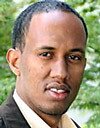 As a member of the Somali community in Seattle, I was shocked and terrified when I heard that the suicide attack against the peacekeeper’s compound in Mogadishu was carried out by a Somali American with ties to Seattle. The suspect’s father was quoted saying “He’s very sorry about the tragedy” and “ashamed of the whole thing.” These feelings are shared by Seattle’s Somali community.
As a member of the Somali community in Seattle, I was shocked and terrified when I heard that the suicide attack against the peacekeeper’s compound in Mogadishu was carried out by a Somali American with ties to Seattle. The suspect’s father was quoted saying “He’s very sorry about the tragedy” and “ashamed of the whole thing.” These feelings are shared by Seattle’s Somali community.
There is no question that we all reject and condemn any terrorist act or tendencies. At the same time, I also want to shine a spotlight on another face of this tragedy.
As a former refugee, I know how long it can take to come to America and the hardships immigrants encounter on the way. Immigrants and refugees come to this country with great hopes and expectations to make a better future for themselves and their families.
We must ask ourselves, then, why some kids who come to this country at the age of 2 to 4 fail to live the American dream, turn away from the country their family fled to, and end up victimizing others?
The Seattle Times wrote that “outside influences” may only be one factor for radicalizing those youth. The real issues that make young Somalis and East Africans so vulnerable to acts of violence are not so simple. There is a shortage of appropriate social, educational and cultural resources and support to keep them away from gangs and violence. Overwhelmingly high dropout rates exist among immigrant youth with no culturally appropriate outreach from schools. Traditional anti-youth-violence programs don’t reach immigrant youth. And most city services simply don’t reach and support immigrant kids.
Let me be clear that there is no rationalization for violence. But if we are honestly interested in dealing with the realities of youth violence, we have to dig more deeply.
Imagine if you were a 15-year-old refugee student who has never attended any regular school system and were placed in 10th-grade classes with no adequate cultural and educational support. Everything would be new to you: the teachers, the education system, the language and the rules.
Imagine that you are given a reading assignment and have trouble with your homework. You ask your parents for help but they cannot. Many refugee parents cannot track their children’s school achievements or assist them with homework because they’re not regular middle-class college- or university-educated parents. They come from countries with different education models, they speak different languages, and many have been torn away from school because of civil war or economic struggle.
Teachers and counselors in school often don’t look like you, speak your language or understand the problems you face. Your parents may be working two jobs. Where do you turn to get help and feel like you belong?
We need to fight security threats to our country but we need to look beyond just law enforcement or security approaches. We need to address the broader context and cure the root of the problem. We need to come together and find creative solutions to help kids survive and succeed in their education and their lives. We need to invest resources and deal with social factors that create these circumstances in the first place.
Our country is a nation of immigrants; their struggles are the struggles of all people who have came to America in our nation’s history to find freedom and opportunity. We want our kids to dream bigger and have the tools they need to become doctors and engineers, rather than turning to harmful or dangerous activities.
______
Source: Seattle Times
 Ahmed Dahir is a member of the Somali community and an organizer with OneAmerica, an immigrant rights organization.
Ahmed Dahir is a member of the Somali community and an organizer with OneAmerica, an immigrant rights organization.






